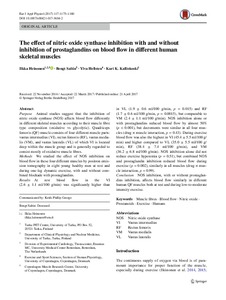The effect of nitric oxide synthase inhibition with and without inhibition of prostaglandins on blood flow in different human skeletal muscles
lkka Heinonen; Ylva Hellsten; Kari K. Kalliokoski; Bengt Saltin
The effect of nitric oxide synthase inhibition with and without inhibition of prostaglandins on blood flow in different human skeletal muscles
lkka Heinonen
Ylva Hellsten
Kari K. Kalliokoski
Bengt Saltin
SPRINGER
Julkaisun pysyvä osoite on:
https://urn.fi/URN:NBN:fi-fe2021042718054
https://urn.fi/URN:NBN:fi-fe2021042718054
Tiivistelmä
Purpose Animal studies suggest that the inhibition of nitric oxide synthase (NOS) affects blood flow differently in different skeletal muscles according to their muscle fibre type composition (oxidative vs glycolytic). Quadriceps femoris (QF) muscle consists of four different muscle parts: vastus intermedius (VI), rectus femoris (RF), vastus medialis (VM), and vastus lateralis (VL) of which VI is located deep within the muscle group and is generally regarded to consist mostly of oxidative muscle fibres.Methods We studied the effect of NOS inhibition on blood flow in these four different muscles by positron emission tomography in eight young healthy men at rest and during one-leg dynamic exercise, with and without combined blockade with prostaglandins.Results At rest blood flow in the VI (2.6 +/- 1.1 ml/100 g/min) was significantly higher than in VL (1.9 +/- 0.6 ml/100 g/min, p = 0.015) and RF (1.7 +/- 0.6 ml/100 g/min, p = 0.0015), but comparable to VM (2.4 +/- 1.1 ml/100 g/min). NOS inhibition alone or with prostaglandins reduced blood flow by almost 50% (p < 0.001), but decrements were similar in all four muscles (drug x muscle interaction, p = 0.43). During exercise blood flow was also the highest in VI (45.4 +/- 5.5 ml/100 g/min) and higher compared to VL (35.0 +/- 5.5 ml/100 g/min), RF (38.4 +/- 7.4 ml/100 g/min), and VM (36.2 +/- 6.8 ml/100 g/min). NOS inhibition alone did not reduce exercise hyperemia (p = 0.51), but combined NOS and prostaglandin inhibition reduced blood flow during exercise (p = 0.002), similarly in all muscles (drug x muscle interaction, p = 0.99).Conclusion NOS inhibition, with or without prostaglandins inhibition, affects blood flow similarly in different human QF muscles both at rest and during low-to-moderate intensity exercise.
Kokoelmat
- Rinnakkaistallenteet [19207]
